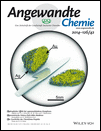Reglucosylation of the Benzoxazinoid DIMBOA with Inversion of Stereochemical Configuration is a Detoxification Strategy in Lepidopteran Herbivores†
We thank the Swiss National Science Foundation (Grant Nr. 136184) and the Max Planck Society for funding. Prof. D. Sicker, University of Leipzig, is acknowledged for providing DIMBOA, Dr. M. Kaltenpoth, for the helpful discussions, the Entomology Department of the Max Planck Institute for Chemical Ecology, for providing insects, and Dr. R. C. Menezes for HRMS measurements.
Abstract
Benzoxazinoids are chemical defenses against herbivores and are produced by many members of the grass family. These compounds are stored as stable glucosides in plant cells and require the activity of glucosidases to release the corresponding toxic aglucones. In maize leaves, the most abundant benzoxazinoid is (2R)-DIMBOA-Glc, which is converted into the toxic DIMBOA upon herbivory. The ways in which three Spodoptera species metabolize this toxin were investigated. (2S)-DIMBOA-Glc, an epimer of the initial plant compound, was observed in the insect frass, and the associated glucosyltransferase activity was detected in the insect gut tissue. The epimeric glucoside produced by the insect was found to be no longer reactive towards plant glucosidases and thus cannot be converted into a toxin. Stereoselective reglucosylation thus represents a detoxification strategy in Spodoptera species that might help to explain their success as agricultural pests on benzoxazinoid-containing crops.




